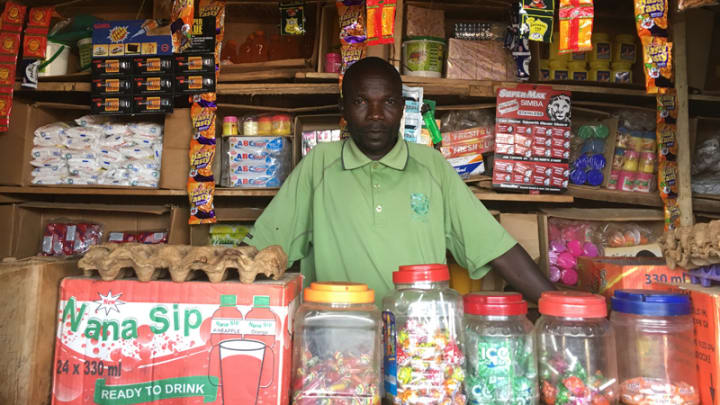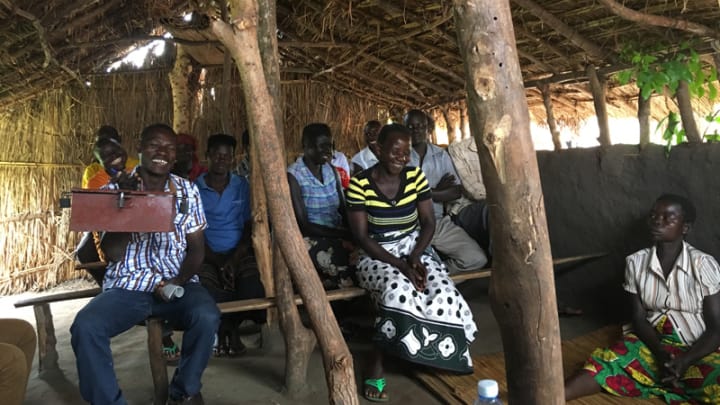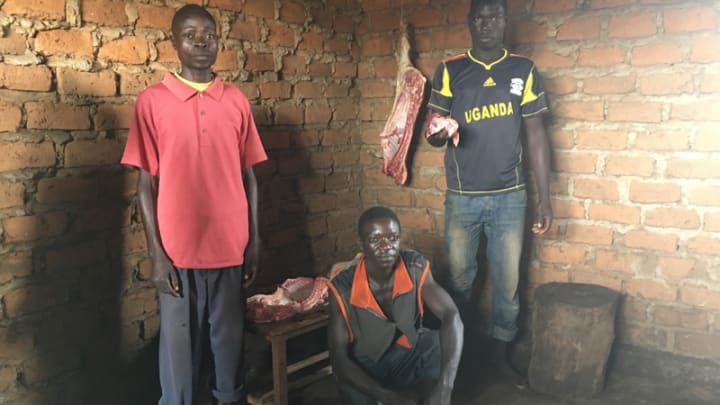
KIRYANDONGO, Uganda — The small shop where Charles Gwokajja sells cooking oil, soaps, tea, and sweet treats sits an hour from the main road, down a muddy pothole-filled lane lined with maize fields. At this time last year, he was a subsistence farmer, struggling to cover basic family expenses. Now he and his store’s two co-owners have enough income to buy medicine when someone is sick, and even to save money.
The shop began in his home, but with a $100 grant to him and two women in his community, the trio graduated to a storefront in a more central location in the community. Despite ups and downs in prices and sales, the business is growing and profitable, bringing in about 15,000 Ugandan shillings surplus (about $4.17) a week.
“It has helped us in emergencies, like when one of us falls sick, we can take some of the money and go to the hospital, or get medication,” Gwokajja said through a translator. “Another benefit is that it has increased our savings, when we have a good profit we take it and divide it, the three of us, and take it as savings.”
Gwokajja’s story is one of several thousand supported through Village Enterprise, a nongovernmental organization working to eliminate poverty in sub-Saharan Africa through entrepreneurship and innovation. The organization’s network of entrepreneurs is set to grow significantly through a new development impact bond that is trailblazing many firsts — the first in the world to focus specifically on poverty alleviation, the first in sub-Saharan Africa, and the first to bring on major donors, including the U.S. Agency for International Development and the U.K. Department for International Development.
The development impact bond is a results-based financing mechanism, where investors provide upfront capital for an intervention implemented by a service provider. The investors are paid based on specific, closely measured results by an outcome payor. There are only two other active DIBs in the world, one in India focused on education and another in Peru on cocoa and coffee, although several others, most of which are focused on health, are in development. The Village Enterprise DIB has a total budget of $5,260,005, making it the largest DIB to date.
All those involved, including the world’s two largest development agencies, are looking to the intervention as a test case of whether DIBs should be among the tools in their anti-poverty toolkits. If it succeeds, it could not only help lift thousands out of poverty, but could provide a blueprint and structure that would make future DIBs easier. The financing may help scale the graduation model, which already has a body of evidence proving its efficacy. If it fails, meanwhile, the investors won’t get their return, and it could set back the emerging use of DIBs as a results-based financing tool.

The intervention
Village Enterprise uses a combination of training and cash grants to help communities start microenterprises, building their assets and savings.
The organization works with the ultra poor in Uganda and Kenya, reaching about 12,000 households. They initially assess communities using the Progress out of Poverty Index created by the Grameen Foundation, which uses surveys to identify poverty levels among individuals and in communities. Once the poorest segment of the population is identified, Village Enterprise reaches out to a group of about 60 people to introduce them and others in the community to their program.
From those initial conversations, the organization identifies a group of about 30 potential entrepreneurs who undergo two months of training on financial literacy and business skills. The program targets women and tries to help address some of the challenges that they face — from cultural barriers, to legal barriers, to literacy challenges.
See more related stories:
► Can a UN social impact fund spark further reform at the organization?
► ICRC launches world's first Humanitarian Impact Bond
► A development finance glossary
During the training, participants form three-person groups to identify what kind of business they want to create. Each group is then given a roughly $100 grant to buy key assets or animals. Business mentors visit the groups at least twice a month for six months, advising them on their operations, ensuring that they’re keeping good records, and helping them troubleshoot. About 10 of those business groups, or about 30 people, also form business savings groups, wherein they will save and pool their resources.
At the end of the six months, businesses that have shown stability and growth receive a second grant. After about a year, Village Enterprise hands over full leadership to the community.
At a weekly business savings group meeting near Kiryandongo on a recent Friday afternoon, members shared stories of starting very small — selling a bag or two of maize or raising a couple pigs — and then expanding into true small businesses. In 2015, when Village Enterprise first helped launch the group, they distributed 2 million Ugandan shillings ($555) once a month from collective savings. Last time they shared out, they distributed about 13 million Ugandan shillings (about $3,600).
The business savings group has a board and a complex set of guidelines spelled out in a roughly 20-page constitution, including protocols for how to admit new members, and the management of finance. They are also partnering with banks to link members finance and savings options and are considering buying joint assets, such as an ox plow.
The impact on their lives was measureable, they told Devex.
“I’m now saving very well, I’m even sending my children to school, I can feed my family very well. I can do what I used not to do before because I am in the savings group,” one of the women in the business savings group said through a translator. Another added that before participating, she didn’t even think of sending her kids to school, but she got the idea from the group and is able to save the money she needs to enroll her children.
The impact extends beyond the initial group of business owners and members of the business group. Others in the community have taken notice, leading the business savings group to nearly double in size.
“They have seen how our families are doing well and some of them admire the clean compound, that we have latrine, the clean environment around the home,” one of the group’s board members told Devex. “They say, why do these people have cleaner homes than ours? Let us join that group so that we can also get the knowledge from that group.”

The DIB
In 2013 Village Enterprise launched a randomized control trial, which evaluated the impact of their intervention a year after they handed off projects to communities. After participating in the program, they found people consumed more and had more assets. Armed with their data, the organization began to explore funding opportunities to scale.
The resulting DIB is structured slightly differently from previous bonds. First, instead of paying back the investors directly, the outcome payers — USAID, DFID, and an anonymous donor — will all pay into an outcomes fund, which will be managed by a third party. If Village Enterprise delivers on its goals, then either investors or the organization itself will get paid back through the outcomes fund.
The DIB gives Village Enterprise access to a larger pool of capital that is more flexible than what they might receive through more traditional grants, in part because it spreads the risk across more actors.
“We’ve been working towards building a model that’s scalable and replicable so we can achieve our mission of ending extreme poverty in sub-Saharan Africa through entrepreneurship and innovation,” said Dianne Calvi, the CEO of Village Enterprise.
New funding from the DIB should roughly double the number of ultra-poor people Village Enterprises can reach in the next two years and fund about 50 percent of the organization’s work. It currently reaches between 12,000 and 13,000 people a year.
“I feel pretty confident in the organization’s readiness to scale,” Calvi said. “Obviously when you are paid on performance, it is even more critical that things work the way they say it will work.”
Also unique to this DIB, Village Enterprise is responsible for bringing in the investors and raising the working capital, which it will continue to do. Finding investors is a job traditionally undertaken by an intermediary, the independent organization that helps structure DIBs. An intermediary’s incentive is often to get the fastest money possible. With this structure, the implementer can raise the investment or working capital over time and be a bit pickier about what money they take, which may mean securing cheaper capital.
The DIB will assess poverty reduction by measuring increases in consumption and net assets. If Village Enterprise achieves the performance it did in the earlier RCT as they scale, they will be repaid the investment with a small return of between 1 and 2 percent. If they improve performance by about 25 percent, the rate of return will be between 16 and 18 percent, but there is a cap on outcome payments.
Given the challenges of maintaining results at scale and the volatility of the areas the organization is working in — a bad harvest or livestock disease could fairly easily set back any gains — this is an ambitious target, said Avnish Gungadurdoss, the managing partner and co-founder of Instiglio, the DIB’s intermediary. Instiglio helped structure the deal and will track learnings that could help streamline future efforts.
This DIB’s structure is intended to speed up the amount of time it takes to launch a DIB and try to reduce the overhead costs by changing incentive structures and having more work done by the service provider, he said. The setup also allows for future growth, as other outcome payers and intermediaries could join if it proves successful. Finally, the arrangement would allow foundations to meet spending requirements through an upfront contribution to the fund, rather than payments over time. That set up allows donor agencies to more easily participate, given some of their process and budgetary rules.
The donors
This is the first time both USAID and DFID are outcome payers in a DIB. Both had been looking for the right opportunity to test the model. USAID’s Development Innovation Ventures had been seeking the chance to “get involved with aggressive results-based financing, like a DIB,” said Anne Healy, who leads DIV.
USAID, through DIV, will provide $1.3 million to support the management of the DIB, partly fund the randomized control trial tied to the DIB, and contribute to the outcomes fund. DFID invested about $2 million, most of which will go to the outcomes fund.
Donors see the DIB as both an opportunity to expand poverty alleviation work, as well as to contribute to a body of evidence about results-based financing mechanisms.
USAID was particularly interested in this DIB because of the body of evidence supporting a graduation model of entrepreneurship promotion. DIV’s mission is to help remove barriers and scale proven interventions; in this case, the barrier was financing. “So one way to think about removing the barrier to scale is to get creative and innovative around funding mechanisms,” Healy said.
The DIB also provides incentives and flexibility to drive down delivery costs, potentially improving the cost effectiveness of the graduation model, she said.
DFID, meanwhile, first began examining the feasibility of impact bonds in early 2014. The agency funded a pilot exploring a potential health-related DIB in Uganda between 2014 and 2016. More recently, DFID’s economic development strategy said the agency will “assess the scope for financing programmes through development impact bonds.”
DFID declined to comment in detail about this DIB, but confirmed it was exploring innovative ways to finance programs and is participating in this DIB.
“Realistically DIBs are just one of a whole spectrum of results-based financing mechanisms,” said Healy. “I think many donors are trying to think more about how do we use a full spectrum of tools, but use the right tool in the right context.”
Read more international development news online, and subscribe to The Development Newswire to receive the latest from the world’s leading donors and decision-makers — emailed to you free every business day.




